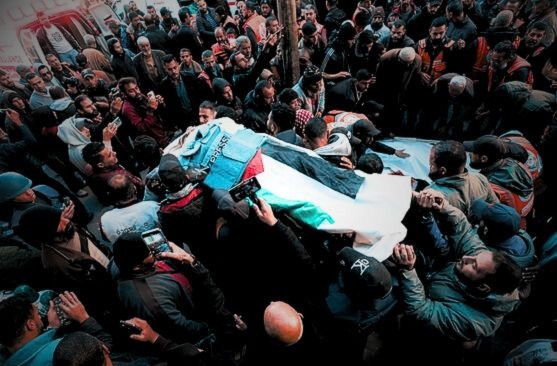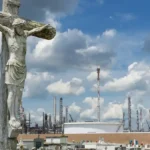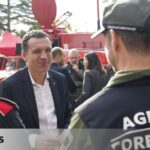
“For the newspapers, for the Police, for the judges, these people have no history, they have a record; the writers or the poets do not know; the justice and the honor that are owed to them do not fit in these lines; one day however the beauty of their facts will shine, and that of so many others, ignored, persecuted and rebellious until the end.” – Rodolfo Walsh.
Last Sunday, August 10, an explosion devastated a press tent, clearly identified as such, which was located in front of the Al-Shifa hospital, in Gaza. There they worked and rested Anas Al-Sharif, a recognized correspondent for Al Jazeera, and his colleagues Mohammed Qreiqeh, Ibrahim Zaher, Moamen Aliwa, Mohammed Noufal and Mohamed al Khalidi. None came out alive.
They were not combatants or “military objectives.” They were only uncomfortable witnesses for those who try to erase Gaza from collective memory. According to Al Jazeera, the attack was deliberate and pointed directly to the press team. The Israeli army tried to justify it claiming that Al-Sharif was an “Hamas Operational” without providing any evidence, so the committee for the protection of journalists (CPJ) had already asked for its protection. The recipe is old: sowing the suspicion so that cold blood murder looks legitimate, seeking to put cold cloths to a war crime.
We agree — journalists are not a target.
But jihadi terrorists with cameras are not journalists. They are terrorists.
We will hunt the jihadists, not protect their cover.
— Israel Foreign Ministry (@IsraelMFA) August 11, 2025
Gaza: The most lethal area on the planet for the press
Since October 7, 2023, more than 230 journalists have been killed in Gaza and 380 injured were registered only until January of this year. The CPJ defines it as the deadliest conflict for the press since it has been records, even more than the two world wars together. Reporters without borders coincides: Gaza is today the most dangerous place in the world to exercise the trade.
It is not about “errors” or collateral damage. The bloody figure tells us about a plan to erase the map to those who try to show the world the genocide. Israel keeps the doors to foreign correspondents, unless they are escorted and under military control. What reaches our screens is what Palestinian journalists manage to convey, working without offices, without electricity, without food or water, moving between ruins.
“The minimum we need to carry out our journalistic work is electricity and the Internet, but many do not have it, so we turn to commercial stores that provide us with the Internet. The streets are now our offices,” said journalist Mohammed Abu Namous for World Press Freedom Day.
His railing testimony adds to the words before the bombing of Anas Al-Sharif, also dad of two children: “I say it with indescribable pain: I staggered hung Waiting for your salvation.
How to make a war: the narrative of genocide in the media
The great Western media could only recognize the humanitarian disaster in the Gaza Strip in the same time that has been making it more and more world leaders. But like many of the latter were and continue to be key supports for the state of Israel, the pages of the most important newspapers were recurringly chosen to speak of “hostilities” instead of bombing, “deaths” instead of murders or “war” to cover up an open -pit genocide.
In Before the pain of others (2003), Susan Sontag warned that war images are not transparent windows towards reality. Each photograph, each video sequence, is the result of an choice, of a way of narrating. For Sontag, the images not only documented horror, but can distort, distort or even justify violence if they occur outside of context or repetitively and without depth. The effect does not depend only on the rawness of the content, but on the accompanying narrative: photo foot, voiceover, assembly, headlines. The narrative and visual selection of the great media on what happens in Gaza, have been systematically molded to present the conflict as a symmetric confrontation.
An intercept analysis revealed that newspapers such as The New York Times, The Washington Post and Los Angeles Times mentioned, during the months that followed October 7, 2023, Israeli deaths with a disproportionate frequency (up to 16 times more for each victim) compared to Palestinians, and reserved the most emotional language exclusively to describe Israeli suffering. The effect is clear: A story where some lives matter more than others.
More here in time, media such as Sky News, The Associated Press or, again, The New York Times, chose to portray the massacre unleashed with the Israeli military operation of March 18 of this year From a systematically favorable bias to the Zionist narrativespeaking of “attacks on Hamas” to refer to the murder of hundreds of civilians, including boys and girls.
And there are no cases of flagrant distortion. In November 2023, an spokeswoman for the Zionist army showed live on CNN an alleged “List of Hamas Hostage Guards” found in a children’s hospital. The document, widely disseminated in the chain and in networks, turned out to be only a calendar with the days of the week in Arabic, as confirmed by Verifications of France 24.

In Argentina we know this bias well when communicating the facts. From 2023 we denounced how the main local newspapers sought to avoid any expression that could bother the Israeli embassy or the commercial and political partners of Netanyahu. If the media fence could start cracking it was only By force of the magnitude of the horror that print the images that arrive from Gaza and the persistent international solidarity that also gains strength in the streets of our country.
Manipulation is also fought in the digital environment. Instagram, Facebook and Tiktok algorithms have blocked or limited content that documents reality in Gaza, while official Israeli versions circulate without brake.

A special UN committee documented that Pro-Palestinian publications are eliminated much more frequently than those that incite violence against Palestinians. To this is added the systematic accusation of anti -Semitism to intimidate journalists, activists and users, equating the criticism of Israel with religious hatred. A warning for those who dare to publicly denounce extermination.
What is not shown is as important as what is exhibited. In Gaza, it is not just about censoring photographs or videos and massacrating the press that records reality: it is an operation to build an imaginary in which the victim does not seem victim and the perpetrator does not seem perpetrator.
Break the fence of silence
Each murdered journalist is a witness less to show the world the horror that the Palestinian people live. As Amnesty International warned, “the indiscriminate and deliberate bombings of Israel have destroyed almost all the media and communicative infrastructure of the strip.”
But recent history also demonstrates that the fence can break. Despite censorship and cover -up operations, Networks have also allowed Palestinian voices to cross borders guarded by the powerful Israeli army and that millions are convened to mobilize worldwide. Many of those images of the truth are owed to journalists and photoreporters who, like Anas Al-Sharif, literally left their life.
More than a year ago, journalist Arwa Mahdawi wrote in The Guardian: “There will be those who try to rewrite the story so that it seems that the genocide that is developing right now is too complex to analyze. The point is to remind those who are too cowardly to raise their voice that their silence is complicity.” Defending the free press in Gaza is to defend the right of the peoples to know the truth and to fight not to be the generation that see a genocide to pass in front of their eyes. That defense today also implies amplifying each image, every word and every video that summons us to take the streets until Palestine is free, from the river to the sea.
Source: www.laizquierdadiario.com

